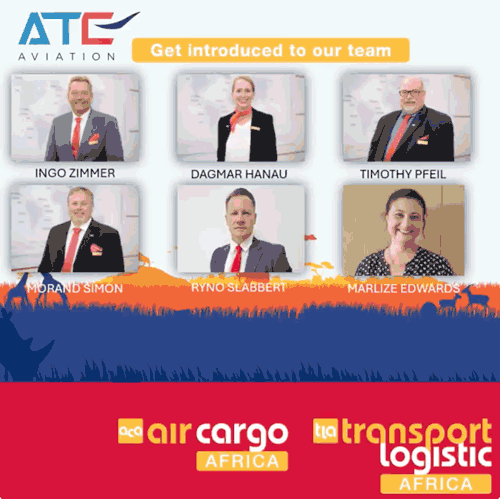
 |
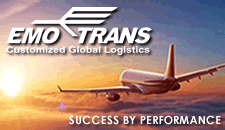 |
 #INTHEAIREVERYWHERE |
| Vol. 24 No. 7 | Wednesday February 19, 2025 |
| |
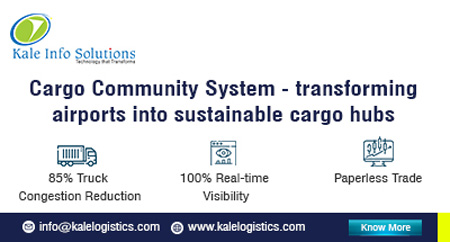 |
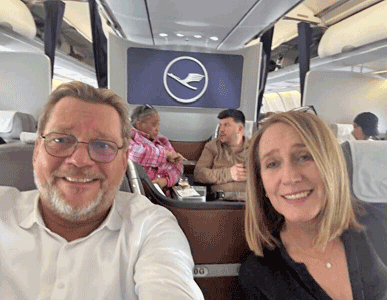 Nairobi
Bound. Nairobi
Bound.Ain't got no heebie- jeebies -hangin'round! Best in show . . . Here we go— We're Nairobi, Kenya bound! Air Cargo Africa takes off February 19-21 . . . Here Ingo Zimmer, CEO and Dagmar Hanau, Group Marketing Manager ATC Aviation Services AG were on their way to greeting delegates and advancing why ATC is the best GSSA in the world at Africa's premier air cargo confab in 2025. Drop by . . . Say hi! Stand Number C-37. |
Meeting this week at Park Hyatt Doha, Qatar, the Annual Animal Transportation Association (ATA) Conference February 16-19 is not just horsing around. The 51st ATA Conference features what you need to know in the animal transportation industry, including a variety of workshops and panels on topics of interest to animal transportation professionals, via a number of social and networking events. Not much publicized, and perhaps in the shadow of events this week in Nairobi and elsewhere, this organization deserves attention and support for its great work, delivering dedicated focus to developing safe and humane animal transport worldwide. The ATA Annual includes a number of opportunities for animal transportation professionals to learn about the latest technologies and resources that can help them improve their work. ATA was founded in 1974 by a group of animal transportation professionals who were eager to promote the safe and humane transportation of animals. Over the past 51 years, the ATA has grown to become the most respected professional organization for animal transport in the world. Even with announced support from The International Air Cargo Association TIACA, ALACAT, International Air Transport Association (IATA) and others, maybe you missed this conference. IATA sent Maria Jitomirski, Manager Special Cargo who spoke Tuesday on “Standards & Regulation Innovations,” and that was just one highlight of this most diverse and technical event. Roundtable discussions on the menu opened up ideas and solutions airing out “Risks In Transport”. Later, after an interesting presentation on Sheep Handling Strategies by Charlie McMullen, CEO of Intradco Global, a Livestock Roundtable Discussion rocked the room. Nice looking, powerful and committed people, both young and energetic and older, but all wise to best practices on how to move our four-legged friends so everybody can say ,"thanks for the ride". Not to be forgot, with a tip of the hat to Qatar Airways Cargo, which hosted and welcomed and sponsored ATA in Doha this week. Qatar Cargo Live Animal Centre is the hub, where conferees are situate in the premier animal shipping operation in the world. Apropos of all of this, QR Cargo has placed on Page One of their very hi-tech Animal Centre website some words that tell you right away where they are coming from: “Those who teach us the most about humanity aren’t always human.” Those words by author Donald L. Hicks are at the heart of Qatar Animal Centre’s philosophy about caring for animals in transit. More on ATA here. GDA |
The passion of Europeans for street naming is old and intractable. As effective as the numbered streets and avenues of the USA could be, they remain far from our hearts. Europeans favour streets with names, even in America: we like Broadway, Lexington . . . even Wall Street, whilst we are instinctively puzzled by 5th Avenue’s insufficiency, even if it is fashionable and excellent, as only an avenue in NYC could be. Street naming has been a constant exercise for centuries in this continent, and still continues. For example, in Lewisham (UK) you may ask for a brand new street name for yourself and get it signed and sealed at the affordable price of 462 pounds. The passion for street naming is one of the few common traits that all Europeans have in common, over and above any other. Trafalgar Square in London echoes Les Champs Elysées in Paris, ideally extending their charms to the Nevsky Prospect in St. Petersburg, but we know that ‘all roads lead to Rome’, where Piazza Navona welcomes you with its almost oval embrace, thus evoking ancient Roman ship battles (naumachia). 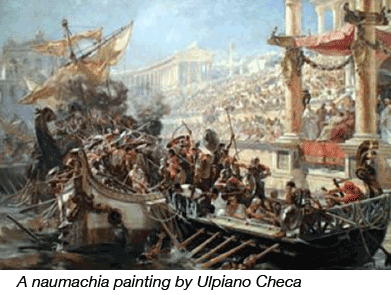 Every European city has a road, a street or
a square to remember. Even the smallest alleyways have their names, which
proudly connect you with personalities or events in history or geography.
In my home town, Turin, significant names affixed at road corners evoke
famous Romans like Julius Caesar, emperors like Trajan or even the locally
relevant Madame
Royale Christine Marie. We even have a big thoroughfare, still called
Soviet Union Avenue, more than thirty years after the demise of the political
entity it celebrates. Some have a different story to tell, though, not connected
with power, empire and territory, but with transport, logistics and trade.
This is the story of a tunnel that my friend Rosalba Graglia and I want
to tell you today. Rosalba is a friend, a former school mate of mine, for
years active as an independent journalist writing for a number of media,
including Corriere della Sera and Bell’Italia.
Every European city has a road, a street or
a square to remember. Even the smallest alleyways have their names, which
proudly connect you with personalities or events in history or geography.
In my home town, Turin, significant names affixed at road corners evoke
famous Romans like Julius Caesar, emperors like Trajan or even the locally
relevant Madame
Royale Christine Marie. We even have a big thoroughfare, still called
Soviet Union Avenue, more than thirty years after the demise of the political
entity it celebrates. Some have a different story to tell, though, not connected
with power, empire and territory, but with transport, logistics and trade.
This is the story of a tunnel that my friend Rosalba Graglia and I want
to tell you today. Rosalba is a friend, a former school mate of mine, for
years active as an independent journalist writing for a number of media,
including Corriere della Sera and Bell’Italia. As in all stories, there is a plot, but there is also an exception. So let us start with the exception, as it manages to connect street names and transport infrastructure, which is the reason why we write this for the FT. Passenger transport being outside of FT’s interests and our common practice, we shall solely deal with aspects affecting the trade of goods. 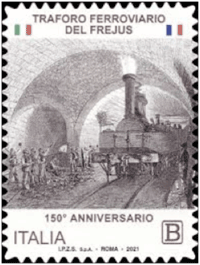 SITO,
the transport and logistics terminal
of Turin has streets with numbers and no names and remains with the
simplicity of 1st street, 2nd street etc. This inland port is the combined
road-rail terminal that years ago was conceived to receive the cargo volumes
generated by the high-speed rail connecting Italy and France: the Turin
– Lyon 5th corridor, as was named at inception. More in general this
rail connection was supposed to speed traffic between Paris, Lyon, Turin
and Milan, and Venice for that matter, up to Budapest and Kiev, whilst also
ensuring the long awaited high speed connection between Paris and Rome.
To date, several decades after its debut as a concept, we are still many
years away from its completion. High speed exists either sides of the Alps,
not in between. So much for EU’s grand infrastructure plan, recently
re-baptised “Connecting
Europe Facility”! For the record, the Swiss have constructed three
tunnels of similar impact in the meantime, with their own money and without
making a buzz… SITO,
the transport and logistics terminal
of Turin has streets with numbers and no names and remains with the
simplicity of 1st street, 2nd street etc. This inland port is the combined
road-rail terminal that years ago was conceived to receive the cargo volumes
generated by the high-speed rail connecting Italy and France: the Turin
– Lyon 5th corridor, as was named at inception. More in general this
rail connection was supposed to speed traffic between Paris, Lyon, Turin
and Milan, and Venice for that matter, up to Budapest and Kiev, whilst also
ensuring the long awaited high speed connection between Paris and Rome.
To date, several decades after its debut as a concept, we are still many
years away from its completion. High speed exists either sides of the Alps,
not in between. So much for EU’s grand infrastructure plan, recently
re-baptised “Connecting
Europe Facility”! For the record, the Swiss have constructed three
tunnels of similar impact in the meantime, with their own money and without
making a buzz… As we know only too well, it could be even worse! For two years even the old rail line was discontinued due to a landslide and we were isolated again after one and half centuries. We do not need to build walls here in Europe: we may simply sit idle and let the mountains separate us and seal the borders. What an evolution! Getting back to SITO, the terminal with no street names, it was launched in 1980. “The Piedmont Region, implementing the regional transport plan to promote the reorganisation and rationalisation of freight transport, promoted the construction of public works of infrastructure for the handling of goods and for the interchange between road, rail and other transport modes . . . ” The publicly declared Company's purpose was “the promotion, planning, financing, and possibly direct and indirect construction of a multifunctional inland port in the areas adjacent to the Orbassano railway shunting yard . . . ” 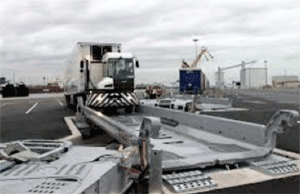 Since
the first stone was laid in 1985, the terminal has been developed to include
3,000,000 sqm of surface with 400,000 sqm of equipped areas and services,
100,000 sqm of office space, 900,000 sqm of storage areas and 60,000 sqm
of rail connected warehouses. 150 companies work in the compound employing
4000 FTE’s in logistics, all busy along 13 kilometres of rail tracks
surrounded by 150,000 sqm of outdoor storage terminal and 100,000 sqm terminal
area, catering for 4,55 million vehicles annually. In 2023 500 trains, with
16,430 wagons, 85% of these from intermodal traffic, as well as 30,000 containers
were handled. We shall spare you greater details, diligently supplied by
SITO, just to tell you that these figures would probably be considerably
higher, had the Frejus
base Tunnel been completed in time. Since
the first stone was laid in 1985, the terminal has been developed to include
3,000,000 sqm of surface with 400,000 sqm of equipped areas and services,
100,000 sqm of office space, 900,000 sqm of storage areas and 60,000 sqm
of rail connected warehouses. 150 companies work in the compound employing
4000 FTE’s in logistics, all busy along 13 kilometres of rail tracks
surrounded by 150,000 sqm of outdoor storage terminal and 100,000 sqm terminal
area, catering for 4,55 million vehicles annually. In 2023 500 trains, with
16,430 wagons, 85% of these from intermodal traffic, as well as 30,000 containers
were handled. We shall spare you greater details, diligently supplied by
SITO, just to tell you that these figures would probably be considerably
higher, had the Frejus
base Tunnel been completed in time. In 1980 we had hopes to see the high speed rail to Paris before the year 2000 and today we still have hope to see it before we die. This is probably the biggest shortcoming in transport infrastructure, in EU’s development and transport policy that I have witnessed so far. And the disillusion is bitter, if you check the records and see what happened in this part of the world one and a half centuries ago. Quite the opposite was normal and exceptional at the same time, in fact! Let us then get back to the time when we were able to think, lay-out and construct the longest rail tunnel in the world, in record timing, too . . . But we shall also explain how this connects with our street naming passion: the names of those involved in the project and implementation of this grand plan are all affixed at the corners of our urban streets. Not all of them are so easy to find, tough. In Turin there are signs – and stories – that appear in ways you do not expect, in particular, since the genteel habit of affixing road signs bearing some kind of information gave way to the usage of plaques bearing nothing more than a name and surname (at times just the latter). So you have to go and find it out for yourself what it means. 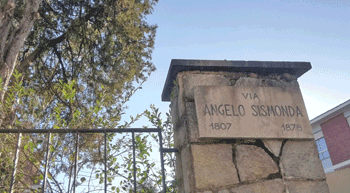 That
is the lot of the street named after Angelo Sismonda, an important and alas
almost forgotten Piedmontese, who was born in Corneliano d’Alba in
1807, studied pharmacy in Turin, but never graduated, preferring physics,
chemistry and above all mineralogy. For this reason, age 21, he moved to
Paris, where he attended the lectures given by the famous mineralogists
and geologists of the Sorbonne, the École des Mines and the Musée
d’Histoire Naturelle. He then returned to Turin, became a professor
at the local university and the director of the Museum of Geology and Mineralogy.
In 1834 he made a scientific excursion to the Maritime Alps and the Apennines
of Liguria, trying to create a geological map of Piedmont and Savoy, writing
reports for the Academy of Sciences. His fame reached as far as the Court
and in 1836 King
Carlo Alberto entrusted him with teaching geology and mineralogy to
his two sons. Sismonda’s geological map of Savoy, Piedmont and Liguria
was published in 1862. That
is the lot of the street named after Angelo Sismonda, an important and alas
almost forgotten Piedmontese, who was born in Corneliano d’Alba in
1807, studied pharmacy in Turin, but never graduated, preferring physics,
chemistry and above all mineralogy. For this reason, age 21, he moved to
Paris, where he attended the lectures given by the famous mineralogists
and geologists of the Sorbonne, the École des Mines and the Musée
d’Histoire Naturelle. He then returned to Turin, became a professor
at the local university and the director of the Museum of Geology and Mineralogy.
In 1834 he made a scientific excursion to the Maritime Alps and the Apennines
of Liguria, trying to create a geological map of Piedmont and Savoy, writing
reports for the Academy of Sciences. His fame reached as far as the Court
and in 1836 King
Carlo Alberto entrusted him with teaching geology and mineralogy to
his two sons. Sismonda’s geological map of Savoy, Piedmont and Liguria
was published in 1862.
In the meantime, Sismonda was already pursuing an even bigger scheme. In 1841, a Customs inspector from Bardonecchia, Giuseppe Medail, had presented Carlo Alberto with the project for a railway tunnel through the Alps, under Mont Cenis, to connect Piedmont with Savoy and the rest of Europe. A visionary project for the times, considered unfeasible by most geologists due to its length (about 12 km), but the king liked it. Carlo Alberto was instantly convinced: for a king who went down in history with the nickname of “Re Tentenna” i.e. the king hesitates, that was remarkable. In 1845 Sismonda began his surveys in the Alps and transformed a crazy idea into a feasibility plan that was approved twelve years later. The project was presented to the government of the Kingdom of Sardinia by Pietro Paleocapa, Minister of Public Works, on May 13th 1857 and was immediately adopted. In memory of this, just a block away from the Porta Nuova main station, Turin dedicated a very central square, completed by his statue, to Mr. Paleocapa, a great promoter of the railway development of Piedmont. Work for the tunnel began immediately and the three design engineers and directors of the works were officially called “Fréjus drillers”, as is readable on an inscription in Grandis St. The three drillers patented a new model of automatic pneumatic drill that allowed a 40 years’ job to be done in 13. This new drill was developed by Germain Sommeiller (works’ director) with Grandis and Grattoni, both engineers.
In this unusual case, perhaps unique, the toponymical
force of Turin has done more than just registering names at random. All
the protagonists of this adventure have a dedicated street right in the
area close to the railway line: Sommeiller Ave. overpasses the railway
tracks which start from the nearby station of Porta Nuova, Grandis and
Grattoni gave their name to neighbouring streets close to Porta Susa,
which was in the meantime made Turin’s main station, yet indefinitely
waiting for a high speed train that indeed should have arrived a long
time ago. |
 |
RE: WFS Brings Back JFK Building 260 After we published our story of Cargo Building
260 at John F. Kennedy International Airport (JFK) February 6, we received
a short note from Jerome Trimboli, Jr. that opened up a world of memories.
Jerry, today is Branch Manager New York/JFK USA Savino Del Bene . . .
In the picture at JFK before take-off,
Jerry is all the way left, and Nana Jane, my mother is smiling back at
me today from the middle, no hat. |
 |
If
You Missed Any Of The Previous 3 Issues Of FlyingTypers Access complete issue by clicking on issue icon or Access specific articles by clicking on article title |
||
 Vol.
24 No. 4 Vol.
24 No. 4AirCargo Dallas March Is On Chuckles for January 30, 2025 iPhone Better Than A Diamond India To Host FIATA Event Stake The Year By The Beast |
 Vol. 24 No. 5 ATC Everyone's Valentine Chuckles for February 5, 2025 Under 45 Grows SAF WFS Brings Back JFK Building 260 Cargo Human Care In 2025 The Kelly Act |
|
| |
| Forward this email to a friend |
| Update Profile To continue receiving FlyingTypers |
Publisher-Geoffrey Arend • Managing
Editor-Flossie Arend • Editor Emeritus-Richard Malkin |
Send comments and news to geoffrey@aircargonews.com
|